Yesterday and today we did something entirely new: we traveled about 10 hours to the south to help translate for the Cascade Medical Team. They’re a group of doctors and medical staff from Eugene and Portland Oregon that come one week a year to Guatemala to help the needy poor. A small university just outside of Sololá allows them to take over the campus and set up a field hospital, from which they provide a pretty fantastic array of services, totally for free: general medical consultations, plastic surgery (cleft palate, burns, skin grafts), dentistry, ob/gyn (including surgeries), general surgery (gall bladder removal, hernias, etc.), optometry, opthamology (especially cataract surgeries), and who knows what else.
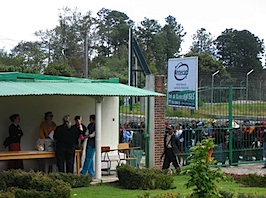 The whole thing was fascinating and amazing, from the moment we arrived. When we got off the bus, we were greeted by a throng of about a hundred Guatemalans waiting in front of the gate. The armed guard noticed we were white, opened the side gate, and waved us in. All the patiently waiting Guatemalans smiled as we entered, figuring we were probably there to help too. We later found out some of them started the line at 3:00am, nearly 9 hours earlier.
The whole thing was fascinating and amazing, from the moment we arrived. When we got off the bus, we were greeted by a throng of about a hundred Guatemalans waiting in front of the gate. The armed guard noticed we were white, opened the side gate, and waved us in. All the patiently waiting Guatemalans smiled as we entered, figuring we were probably there to help too. We later found out some of them started the line at 3:00am, nearly 9 hours earlier.
Once inside, we went looking for Tamra, our contact. We bumped into some friendly doctors wandering around in scrubs, chatted a bit, then eventually found Tamra. “We’re glad you’re here! We have some extra space for you in the dorms. Oh, hey, have you eaten?” she asked, barely taking time to breathe between sentences. “Ok, go over there, that’s the cafeteria, get something to eat, them meet me back here and we’ll find you something to do.” She was off like the wind.
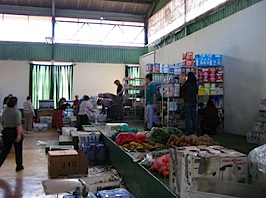
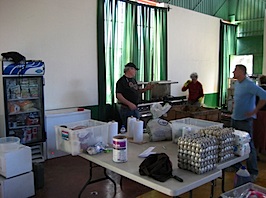 As you might imagine, logistics for setting up a 100-person hospital for a week are pretty complex. We got our first taste of it in the “cafeteria”, a stand-alone gymnasium the kitchen crew had commandeered. They were unloading crate upon crate of food, staging things on steel shelving they’d set up, and a few techs were plumbing gas for a pair of 6-burner industrial stoves. This is where all the hospital and support staff eat for the week. You just show up and get fed. We loved it: real American-style food, all you can eat. For breakfast this morning, they even had bacon! I am ashamed to admit, I went back for fifths, much to the joy and amusement of the cooks.
As you might imagine, logistics for setting up a 100-person hospital for a week are pretty complex. We got our first taste of it in the “cafeteria”, a stand-alone gymnasium the kitchen crew had commandeered. They were unloading crate upon crate of food, staging things on steel shelving they’d set up, and a few techs were plumbing gas for a pair of 6-burner industrial stoves. This is where all the hospital and support staff eat for the week. You just show up and get fed. We loved it: real American-style food, all you can eat. For breakfast this morning, they even had bacon! I am ashamed to admit, I went back for fifths, much to the joy and amusement of the cooks.
Once we ate, we looked for work. The medical techs and surgeons spent much of the first day setting up their operatories, but the translators, general practicioners, and optometrists got right to work. Our task on Day 1 was to triage patients; the translators reviewed referral paperwork and spoke with the patients, getting as much data as possible, and the general doctors then decided where the patients needed to go next: some to pre-surgery screening, some to general consultations, etc. The optometrist’s main job the first day was to find some opthamology patients for the eye surgeons to start with on Monday.
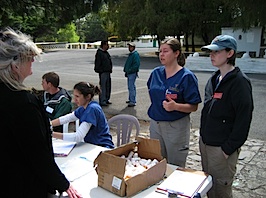 It was cool to be able to use my spanish to help people in a direct, tangible way. “This elderly lady says she has has a big painful lump in her abdomen. Should I send her for a hernia consult?” I would ask the triage doctor, Noreen. “Yep,” she would nod, and I’d send the patient on. Noreen was originally form Oregon, but now works as an ER doctor in Chicago. I think I liked her because she reminded me a lot of Julie, my doctor buddy in Oregon. They’re both about the same age and have simliar personalities.
It was cool to be able to use my spanish to help people in a direct, tangible way. “This elderly lady says she has has a big painful lump in her abdomen. Should I send her for a hernia consult?” I would ask the triage doctor, Noreen. “Yep,” she would nod, and I’d send the patient on. Noreen was originally form Oregon, but now works as an ER doctor in Chicago. I think I liked her because she reminded me a lot of Julie, my doctor buddy in Oregon. They’re both about the same age and have simliar personalities. 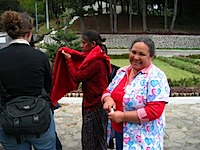 As I was checking in patients, I noticed that those farther back in line were drinking small vials of liquid being dispensed by one of the nurses. “Deworming,” she said, noting my curious look. “We just do it to everyone that even shows up.” She gestured to a HUGE box of deworming medicine I’d not noticed before. For those of you that don’t know, the World Health Organization estimates that one of every two humans on the planet carries roundworm in their gut. Yuk.
As I was checking in patients, I noticed that those farther back in line were drinking small vials of liquid being dispensed by one of the nurses. “Deworming,” she said, noting my curious look. “We just do it to everyone that even shows up.” She gestured to a HUGE box of deworming medicine I’d not noticed before. For those of you that don’t know, the World Health Organization estimates that one of every two humans on the planet carries roundworm in their gut. Yuk.
Later that same day, I was helping one of the GPs in the clinic, and I came across the elderly lady again. “I need her to lie down,” Dr. Paul had me explain. He started examining her, touching her abdomen. “Yep, hernia. She has two. Look, I can push it back in.” He explains to me all about hernias, and that he wants to operate on her, as it is obviously causing a lot of pain and affecting her quality of life. “That, and if it should accidentally get twisted, she will die in a few days,” he added. With medical help unavailable most of the time here, that is how it is. I explained all of it to the 85-year old patient and her daughter. I then found out that she walked 2 hours with her pair of protruding hernias just to get here. The doctor was floored. “You have to understand,” I explained to him. “These older Guatemalans are the toughest people on earth. If you ripped her arm off, she would sit there patiently and not complain a bit, waiting for you to do whatever procedure was next.” This stoicism is admirable, but is sometimes their undoing- we saw a glaucoma patient that “just endured” their blinding eye pain for months before seeking medical attention. But by that time, his optic nerve had been killed by all the pressure, leaving him blind beyond even the reach of modern American medicine.
Speaking of eyes, I spent the second day working with optometrists and opthamologists. One of the optometrists demonstrated that sometimes the people best suited to this work are the older doctors. When the first glaucoma patients showed up, the younger optometrist was concerned because she did not have the electronic gizmo to measure eye pressures. “I saw a (the name escapes me) in the pile of equipment in the back room,” she joked. The older optometrist shrugged. “Get it out, I learned how to use one of those in school.” Everyone stared at him, then someone brought out the tool. It was a stainless steel device with weights and a spring guage pointing to a numeric scale. He cleaned it, went over to the reclining patient, and pressed it against his eye. “This is tricky,” he told me. “I will balance it, you read out the scale reading to me as I move it.” Yep, it was gross- but really cool.
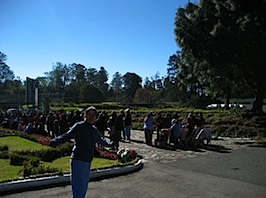 Later, I got to help Mary the eye surgeon with a cataract surgery. Here she is at triage, picking up a bunch of patients. When it came time for the actual surgery, I didn’t really do much; there was a second interpreter, so we traded off some. I DID help Mary by using my leatherman to patch up a piece of malfunctioning surgical equipment (not joking here, folks) in the Guatemalan surgery suite. The eye team had a TON of technical difficluties, as the Guatemalan equipment they were borrowing was old hand-me-down from the US and kept malfunctioning. To make it worse, the probes and syringes etc. that they brought with them from the US were packed by a different opthamologist; Mary and Dee (the RN assistant) had to waste a TON of time sifting through boxes and cartions. I could tell Mary was getting pretty frustrated- a surgery that would have taken her 15 minutes in her own suite in Oregon was still not even started after 4 hours of work. And I
Later, I got to help Mary the eye surgeon with a cataract surgery. Here she is at triage, picking up a bunch of patients. When it came time for the actual surgery, I didn’t really do much; there was a second interpreter, so we traded off some. I DID help Mary by using my leatherman to patch up a piece of malfunctioning surgical equipment (not joking here, folks) in the Guatemalan surgery suite. The eye team had a TON of technical difficluties, as the Guatemalan equipment they were borrowing was old hand-me-down from the US and kept malfunctioning. To make it worse, the probes and syringes etc. that they brought with them from the US were packed by a different opthamologist; Mary and Dee (the RN assistant) had to waste a TON of time sifting through boxes and cartions. I could tell Mary was getting pretty frustrated- a surgery that would have taken her 15 minutes in her own suite in Oregon was still not even started after 4 hours of work. And I 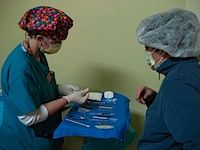 could see her anxiety that these conditions might cause her to mess up. I felt really bad for her. As Dee was prepping a sterile irrigation machine, Mary started the “eye block”, where they neutralize the nerve so they can work. She whipped out a BIG needle, maybe 3 inches long, and announced “you folks might want to look away if you’re queasy.” The other translator turned, and I leaned in closer to watch her stick that needle RIGHT INTO THE PATIENT’S EYE, all the way up to the hilt. The tough old Guatemalan lady didn’t even complain, but I could tell she wasn’t liking it any. “Did you just stick that through the sphere of her eye?” I asked incredulously. Mary rolled her eyes and sighed. “It’s not sphere, it’s globe. And no, I stuck it around her eye and into the nerve in the back of the socket. I suppose that’s better. I guess.
could see her anxiety that these conditions might cause her to mess up. I felt really bad for her. As Dee was prepping a sterile irrigation machine, Mary started the “eye block”, where they neutralize the nerve so they can work. She whipped out a BIG needle, maybe 3 inches long, and announced “you folks might want to look away if you’re queasy.” The other translator turned, and I leaned in closer to watch her stick that needle RIGHT INTO THE PATIENT’S EYE, all the way up to the hilt. The tough old Guatemalan lady didn’t even complain, but I could tell she wasn’t liking it any. “Did you just stick that through the sphere of her eye?” I asked incredulously. Mary rolled her eyes and sighed. “It’s not sphere, it’s globe. And no, I stuck it around her eye and into the nerve in the back of the socket. I suppose that’s better. I guess.
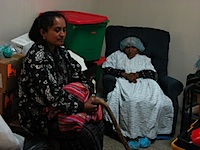 Did I mention that this patient was the same 85-year-old hernia lady I saw the day before? Wow, is SHE going to have a tough week.
Did I mention that this patient was the same 85-year-old hernia lady I saw the day before? Wow, is SHE going to have a tough week.
The Cascade Medical Team’s lab technician was also fun. She is from New Zealand, and VERY enthusiastic about her job at analyzing blood. I spend a while talking to her, and she was pretty excited that my parents both used to do the same job as hers. She explained that back when she learned to be a tech, the program was almost as long as med school, and they had to be able to start up a field lab from almost nothing, including blowing their own glassware. (I vaguely remember my mom telling me a similar story). Nowadays, though, most of the lab tech are just computer operators, and without their gadgets, they’re pretty useless. In the next breath, of course, she showed me a gadget she’d brought with her that looked like an oversized calculator.”This thing costs about $10,000 so I’d better not drop it,” she said. She took a drop of blood from a patient, and put it into a special disposable cassette then into the machine. “For $38 a cassette, I get blood sugar, platelet count, and about a dozen other readings just from one drop.”
She then shifted her attention to some ancient-looking Guatemalan microscopes reminiscent of high school biology class. “You seem resourceful,” she continued. “Can you figure out what’s wrong with these microscope bulbs?” I looked. “Well,the filament looks OK, but sometimes they are broken and you can’t see it,” I explained. She frowned, “I just don’t see how they could BOTH be broken.” She puttered off, to look for a solution. I played with the microscopes for a bit, then discovered a well-concealed rotary switch. Click! they worked. The tech returned a few minutes later. “What did you do?” she asked. “Check it out… a switch!” I said. Everyone laughed. We were back in business, ready to search for parasites and high white blood cell counts. I didn’t mention that my mom used to also get mad at me for tinkering with & breaking things. But it paid off- after a childhood of fixing things I broke, now I can fix most anything.
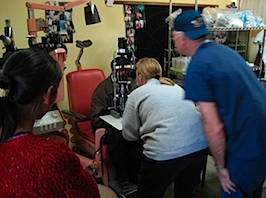 As I mentioned in a post a while back, part of the reason we were involved with this is because of Francisco Juan Fancisco, a guy from our village with serious eye problems. We met him at the front gate, and jumped him ahead of the line and right into a consult with the optometrist. She worked him over pretty thoroughly, dilated his pupils, the whole nine yards. After about an hour of analysis, the optometrist took me aside and explained the situation. “The good news is, his right eye is fine. He shows no signs of a cataract, and his eye irritation is just from environmental stuff like dust, wind, and bright sunlight,” she explained, handing him some artificial tears and a pair of sunglasses. “The other eye, however, is irreparably blind,” she continued. “It appears he had a powerful glaucoma attack that lasted for several months. The pressure cut off blood supply to the optic nerve, killing it. Sadly, we can’t do anything for him.” This was the eye patient I mentioned earlier in the post: he suffered through months of searing eye pain, figuring it would eventually go away and complaining would serve no purpose. But if he’d sought help early on, he could have been treated (assuming treatment was available somewhere) and his eye saved.
As I mentioned in a post a while back, part of the reason we were involved with this is because of Francisco Juan Fancisco, a guy from our village with serious eye problems. We met him at the front gate, and jumped him ahead of the line and right into a consult with the optometrist. She worked him over pretty thoroughly, dilated his pupils, the whole nine yards. After about an hour of analysis, the optometrist took me aside and explained the situation. “The good news is, his right eye is fine. He shows no signs of a cataract, and his eye irritation is just from environmental stuff like dust, wind, and bright sunlight,” she explained, handing him some artificial tears and a pair of sunglasses. “The other eye, however, is irreparably blind,” she continued. “It appears he had a powerful glaucoma attack that lasted for several months. The pressure cut off blood supply to the optic nerve, killing it. Sadly, we can’t do anything for him.” This was the eye patient I mentioned earlier in the post: he suffered through months of searing eye pain, figuring it would eventually go away and complaining would serve no purpose. But if he’d sought help early on, he could have been treated (assuming treatment was available somewhere) and his eye saved.
It was difficult for me to explain the situation to Fancisco Juan and his daughter Maria. How do you tell someone that they made that huge journey for nothing, and that his vision can never be restored? I also warned him, per the doctor’s instructions, that if he experienced a similar pain in his remaining eye, he was to go immediately to an eye doctor to get some eye medicine to prevent this from happening again. Francisco and Maria nodded, and walked back with me to the front gate to start their journey home. They thanked me over and over for helping them, and I tried not to feel silly: I really didn’t do anything. “Can you take us to Emily?” they asked. “We want to thank her too.” We found her in the clinic, and while Francisco thanked Emily, I remembered a last piece of unfinished business. “Here’s the 80 quetzales I owe you for the chickens,” I told Maria. Yep, she’s the Chicken Lady. Our little town is full of strange coincidences.